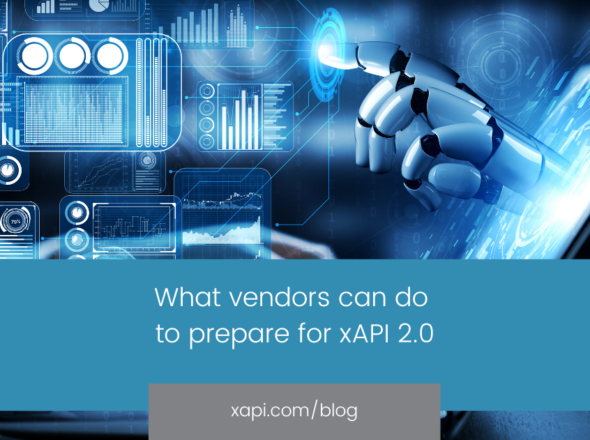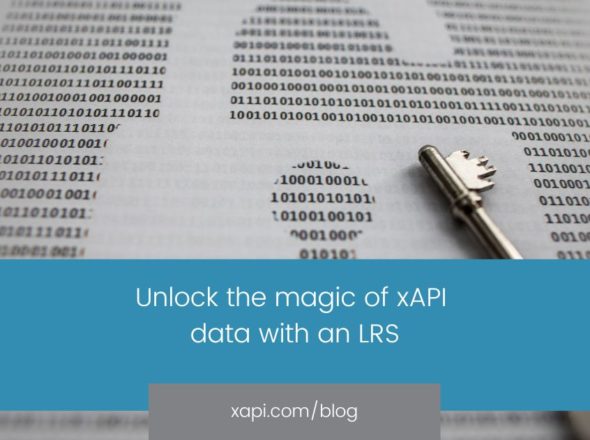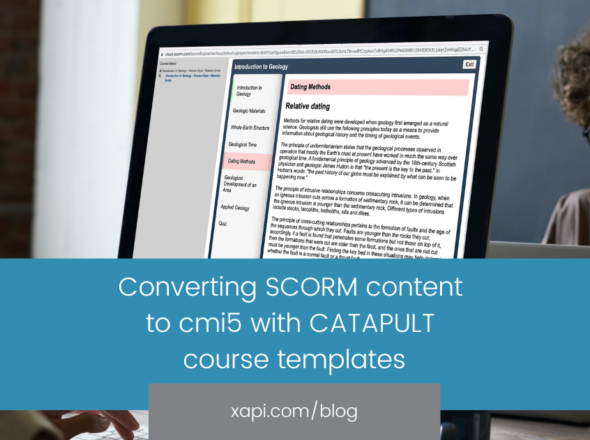When discussing cmi5 and Project CATAPULT, there’s a lot to talk about. The recent informative webinar, “cmi5 Overview and Way Ahead,” covered multiple topics and answered several attendee questions, but the hour was up quickly. If you missed the webinar, you can still view the recording here.
There were so many great questions asked about cmi5 in general, LMS support for cmi5 and Project CATAPULT that we wanted to be sure your questions were answered as well as provide additional references.
cmi5 capabilities
You mention that cmi5 is suitable for use with advanced content. What are some use cases?
cmi5 supports advanced data tracking capabilities that SCORM isn’t extensible enough to allow for, which makes it suitable for tracking learner performance data in high-stakes learning environments, like simulations and virtual reality, that are delivered or launched from an LMS or other learning system.
Can I use cmi5 with videos or PDFs?
The overview of the cmi5 specification states: “This specification describes interoperable runtime communication between Learning Management Systems (LMS) and Assignable Units (AU).” Since you can’t play an MP4 directly in your browser without at least placing it into a video player (even if that’s just the native HTML5 video player), cmi5 provides a framework and standard to load a video player that knows how to send xAPI and cmi5 statements into an LMS that is cmi5 conformant. This provides organization by packaging one or more video players together in one package in a specific order and structure. By doing this with cmi5, statements attached to a learner’s experience can be meaningfully grouped together within a single registration (via cmi5 sessions).
Please share something you can’t do in SCORM that you can do with cmi5.
We’ll share a few key things that cmi5 enables to help inspire you:
- More expressive data. cmi5 enables you to capture data beyond the restrictions of the SCORM data model, which allows you to collect more relevant and meaningful information.
- Distributed content. While SCORM requires the content and LMS to reside on the same server or domain, cmi5 allows you to host your content anywhere.
- Data visibility and portability. SCORM data is stored inside the LMS. Meaning, in order to access your data, you have to ask your LMS vendor to retrieve it and are subject to what the LMS vendor provides, which might not be all of the data. Because cmi5 uses xAPI as the communication and data layer, you have direct data access and can share data captured from cmi5 activities to another LRS.
This chart offers a more indepth review of how cmi5 compares to SCORM,
Are there any examples of what data is captured in cmi5?
The standard has two types of defined data: cmi5 defined Statements and cmi5 allowed Statements. cmi5 defined Statements are required by the specification and are tied to the concept of session/registration management. They include a specific cmi5 category Activity for easy detection and access in the LRS statement stream. cmi5 allowed Statements include the session id and potentially additional information included in the launch data but are otherwise custom to an AU.
Find out more about how cmi5 works or visit Github for examples of common attributes and statements. The cmi5 best practices guide that will be released as part of Project CATAPULT will also include examples and test courseware.
Can I use cmi5 outside of an LMS?
cmi5 requires an LMS or other launching system. For tracking learning activities outside an LMS, it would be appropriate to use xAPI to record and send statements directly to the LRS.
Would it be possible to collect offline data?
Yes. Unlike SCORM, cmi5 does not require a continuous connection to an LMS, which makes it possible to use cmi5 in an offline setting. There are still complexities when it comes to cmi5 in offline activities as a local launching application and LRS for data storage will be needed.
cmi5 and systems
Do LMSs have support for cmi5 today?
Adoption varies widely from vendor to vendor. Contact your LMS provider to ask if they support cmi5 or if they have plans to add support. If it’s not on their roadmap, encourage your LMS provider to add cmi5 support. Customer demand will help speed up support and adoption across vendors. As one person in the webinar commented, asking their LMS vendor to add cmi5 support worked for them.
Rustici Engine, which powers many LMSs, supports cmi5, so your LMS may already have cmi5 support.
If my LMS is currently non-conformant with cmi5, should I create and deploy cmi5 content?
The upcoming cmi5 conformance test suite in development under Project CATAPULT will provide conformance testing later in 2021. But that doesn’t mean you can’t start now. If your LMS has implemented cmi5, it’s definitely worth developing and using cmi5 content now to receive all the additional structural value that cmi5 provides in launch and xAPI statement generation. Plus, the more cmi5 content your LMS vendor encounters now, the more likely their implementation will be fully-conformant by the time the test suite is released!
Can one Learning Record Store (LRS) work with different LMSs?
Provided that the LMS has xAPI support, then yes. LRSs are responsible for receiving, storing and providing access to xAPI statements. The LRS is designed to enable systems to store and retrieve statements and other xAPI metadata from other systems. You can find out more about what LRSs are and how they can work with LMSs here.
When we will need to update our current LMS?
The sooner the better! If you’re running your own standalone LMS instance (one that isn’t automatically updated by your vendor or in their SaaS deployments that they manage), when your LMS vendor tells you that a cmi5 player is available, we’d love to see you update and start using it! If more LMSs add cmi5 support, then more content authoring tools will also add support, leveraging all the advantages that cmi5 offers by combining the structure and rules for launching courseware with the benefits offered by xAPI to collect additional learner experiences and share the data with other systems.
Questions about Project CATAPULT
What is the timeline?
Project CATAPULT is currently in the second phase of development and will wrap up in late September 2021. The final deliverables will include a cmi5 conformance test suite for testing both content and platforms, an open source cmi5 player prototype, sample cmi5 course templates and best practices guide, which will be available publicly after completion.
Is there a demo available somewhere of a cmi5 package being imported and then run in an LMS?
Once the project is completed, demos of the cmi5 conformance test suite, cmi5 course samples and a best practices guide will be available.
Want to know more about cmi5 or Project CATAPULT? Be sure to watch the recorded webinar, view our xAPI Party recording of “Another eLearning Standard?” or reach out and ask us. We’re happy to help.


